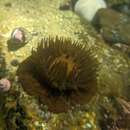Brooding behavior
(
anglais
)
fourni par EOL authors
C. japonicus is a hermaphroditic, externally brooding anemone. Prior to spawning, a cluster of tentacles retract and the oral disc leans in their direction, forming a groove in the column. Eggs or embryos are expelled from the mouth directly into the groove, which elongates and forms a ring as the animal encircles itself, depositing eggs or embryos. Eggs appear to be fertilized internally, but whether they are produced by self or cross-fertilization is unknown. An individual may brood offspring numbering in the hundreds. Spawning is seasonal, with reproductive events taking place in the Autumn. Most offspring are retained no later than August, however there is evidence for some being retained for a year or more. Since this species lacks the free-swimming larval stage, offspring develop directly from embryo to polyp, leaving the adult after they have grown to possess 24-tentacles.

